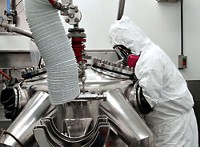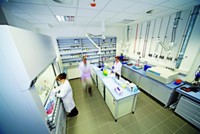Advertisement
Grab your lab coat. Let's get started
Welcome!
Welcome!
Create an account below to get 6 C&EN articles per month, receive newsletters and more - all free.
It seems this is your first time logging in online. Please enter the following information to continue.
As an ACS member you automatically get access to this site. All we need is few more details to create your reading experience.
Not you? Sign in with a different account.
Not you? Sign in with a different account.
ERROR 1
ERROR 1
ERROR 2
ERROR 2
ERROR 2
ERROR 2
ERROR 2
Password and Confirm password must match.
If you have an ACS member number, please enter it here so we can link this account to your membership. (optional)
ERROR 2
ACS values your privacy. By submitting your information, you are gaining access to C&EN and subscribing to our weekly newsletter. We use the information you provide to make your reading experience better, and we will never sell your data to third party members.
Business
SAFC Moves Ahead By Staying Close
Sigma-Aldrich division builds its fine chemicals business by following its customers’ needs
by Ann M. Thayer
April 1, 2013
| A version of this story appeared in
Volume 91, Issue 13

“We are where we are because of the history of where we have been,” says Gilles A. Cottier, president of SAFC Commercial, the contract manufacturing and fine chemicals division of Sigma-Aldrich. “We didn’t get into the fine chemicals space out of a massive strategic plan. We went there because our customers took us there.”
What is now SAFC emerged in the 1990s when customers of Sigma-Aldrich’s catalog chemicals business began requesting quantities larger than research scale. But today, “SAFC is not about quantity, it is about quality,” Cottier says. And it focuses on just two areas: helping pharmaceutical customers develop and manufacture drugs and enabling electronics companies to make semiconductors and light-emitting diodes. Within this tight focus, however, SAFC must still keep its ear to the ground to listen for what its customers want next.
With 2012 sales of $630 million, about a quarter of Sigma-Aldrich’s total, SAFC ranked sixth among fine chemicals suppliers, according to Jan Ramakers, a consultant who benchmarks the industry. It shares the upper ranks with the fine chemicals operations of the European firms BASF, Evonik Industries, Lonza, and DSM, as well as Japan’s Sumitomo Chemical. But unlike these long-standing players, SAFC has moved up only within the past decade, he points out.
SAFC’s growth has come from a series of 10 acquisitions, followed by at least as many capacity expansions. The business has made these moves to try to remain relevant to its key customers. “The fact that we have performed well over the past 15 years is not a guarantee of success,” Cottier says. “We need to continue to listen to our customers and change and adapt.”
SAFC “does not want to be everything to everybody,” Cottier says. After all, the overall market the company serves is 100 times larger in terms of sales than it is. “We want to pick and choose the areas where we want to play, and we want to play to win, not to lose,” he says. “So we are very selective, but this starts with the customer.”
The company makes its choices using a “strategic filter” that has three criteria, Cottier explains. “We do things which are not easy to make, difficult to replicate, and hard to handle.” By choosing to focus on the difficult, “you tend to have less competition.”
SAFC also targets products and services that are critical to the performance of a customer’s product, yet represent only a small percentage of the final price. SAFC still must be competitive with other providers, Cottier says, but he hopes that customers will put cost second to value when they choose a supplier. He sees this balance of quality and price as “a good area to be in, in order to grow profitability.”
SAFC At A Glance
Headquarters: St. Louis
2012 sales: $630 million
BUSINESSES
Life sciences (60%): Raw materials, manufacturing, and testing services to support the biopharmaceutical industry, including cell lines, cell culture media, fermentation, and antibody-drug conjugates.
Custom pharma (20%): Contract manufacturing of highly potent active pharmaceutical ingredients, chiral separations, and preformulation services.
Hitech (20%): Standard and custom-made electronic materials and chemicals, including high-purity inorganics, thin-film deposition precursors, and photoresist dyes.
ACQUISITIONS
Tetrionics and Ultrafine in 2004; Proligo and JRH Biosciences in 2005; Iropharm and Pharmorphix in 2006; Epichem and Molecular Medicine BioServices in 2007; Research Organics and BioReliance in 2012.
In 2012, SAFC grew about 5%, excluding acquisitions, a figure that was slightly lower than stock analysts had hoped for and down from 11% growth in 2011. Its Hitech electronics operation was a dampening factor, with strong sales volumes offset by low prices. However, businesses in cell culture media and contract manufacturing, which focuses on biologic and highly potent drugs, grew in the high single digits.
SAFC got a size boost in 2012 from its $350 million acquisition of BioReliance, which has about $120 million in annual sales. The Rockville, Md.-based company extends SAFC’s reach in services to be a provider of biologic, toxicology, and animal testing for pharmaceutical, diagnostic, and other customers.
Cottier emphasizes the complementarity of the businesses. BioReliance’s safety and quality testing services can support, for example, customers who buy SAFC’s viral particles, antibody-drug conjugates, and biomanufacturing raw materials. “We believe that the idea of services along with products is part of a better and stronger solution for the customer,” he adds.
The firms share many customers, but BioReliance brought some new ones as well. In general, Cottier says, SAFC’s acquisitions not only expand its business, but also shape its strategy and culture through new people and ideas. The company is able to see its customers through a different lens as well as get a better understanding of market dynamics, he says.
Pharma services companies like SAFC believe that close, long-term relationships with customers are critical. “But you can’t be intimate with thousands of customers, and SAFC wants to be recognized as a supplier of choice by its top 100,” Cottier explains. Thus, although the firm still intends to serve all its customers, “we need to disproportionately allocate resources to be intimate with these top 100 and bring value to them.”
Cottier also realizes that the customers SAFC has aligned with today may change. Small customers or ones that buy in only a single service or product area may evolve into something else. For example, one longtime customer started to grow just a few years ago, and this year SAFC expects to see “a significant upside” following a drug approval.
“We have to understand that some customers could sometimes grow by leaps and bounds or other times stagnate because of the way the drug development cycle works,” Cottier says. Although SAFC must answer in the short term to Sigma-Aldrich’s management and shareholders, “we are in a long-cycle business,” he adds.
The long-cycle trends affecting pharmaceutical customers, such as ailing product pipelines and cost containment pressures, are not likely to change over the next five years, acknowledges Deborah Slagle, SAFC’s vice president for marketing and R&D. And these issues affect both drug companies and their suppliers. Suppliers must “not only understand what customers require today, but we need to be able to understand what they are going to need in the future,” she says.
For SAFC, the future looks like it will include a significant push by established pharma firms and new entrants alike to produce biosimiliars, or near copies of biologic drugs. Slagle points out that up to 870 biosimilars are in development. “We definitely see a lot of growth around supporting the biosimilars area,” she adds.
That support is in cell line engineering and in cell culture media and raw material supply. “We are seeing a tremendous amount of uptake with our customers in the Asia-Pacific region,” both Western and local firms, she says. To expand there quickly and cost-effectively, many of these companies are finding it convenient to use single-use or disposable biomanufacturing technologies.
SAFC’s Chinese hamster ovary cell production system, launched in 2012 and called CHOZN, is enabling biosimilars manufacturing, Slagle says. Customer interest ranges from fully customized systems to off-the-shelf cell lines and the companion media. SAFC is adding bulk powder media capacity to its plant in Irvine, Scotland, from which it will supply both emerging Asian customers and existing European ones.
“Asia is an area of significant growth for us,” Cottier agrees. Although Sigma-Aldrich overall has a large footprint in the region, SAFC’s presence is strongest in electronics, with a new manufacturing site in Taiwan. In life sciences it is limited to sales and sourcing. “We don’t have immediate plans on the biological side to have a manufacturing footprint, but we will see as we follow our customers,” he adds.
SAFC is predicting mid-single-digit growth for the first half of 2013 and slightly higher growth for the second half. However, stock analysts raised questions during a March 21 Sigma-Aldrich conference call about BioReliance’s performance and about pricing and overcapacity issues in Hitech’s markets. On the plus side, a new operating structure “is expected to build stronger customer relationships and drive market share gains,” says Goldman Sachs analyst Isaac Ro.
Cottier agrees, saying SAFC’s focus and alignment have become clearer since Sigma-Aldrich underwent a late-2012 reorganization. About $200 million in sales to industrial and diagnostics firms that had been within SAFC shifted to a new applied business division of Sigma-Aldrich. “Our remaining markets are growing at least at GDP growth rates,” he says.
At the same time, Cottier says, SAFC will look to expand organically and through small acquisitions. He’ll be looking, and listening, for acquisitions of the type that helped build the company into the fine chemicals powerhouse it is today.




Join the conversation
Contact the reporter
Submit a Letter to the Editor for publication
Engage with us on Twitter